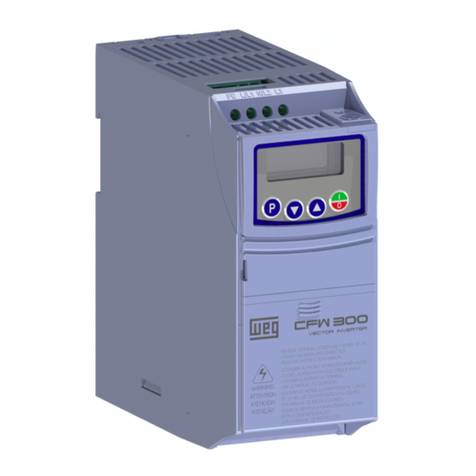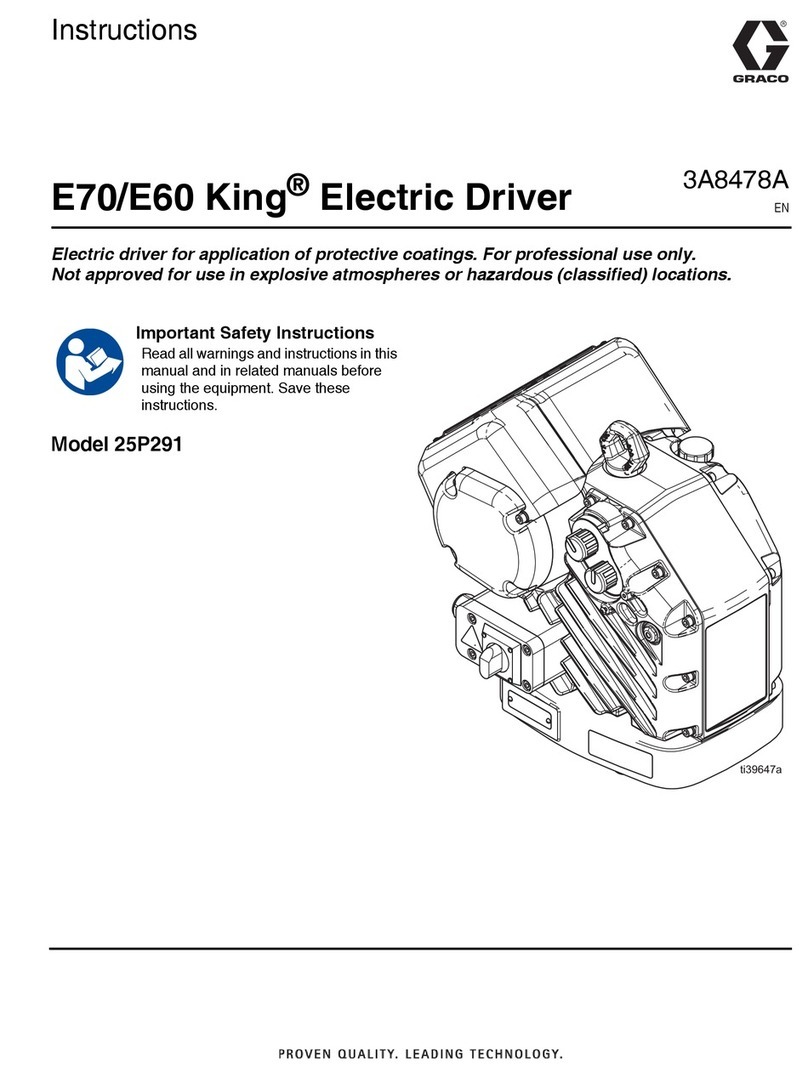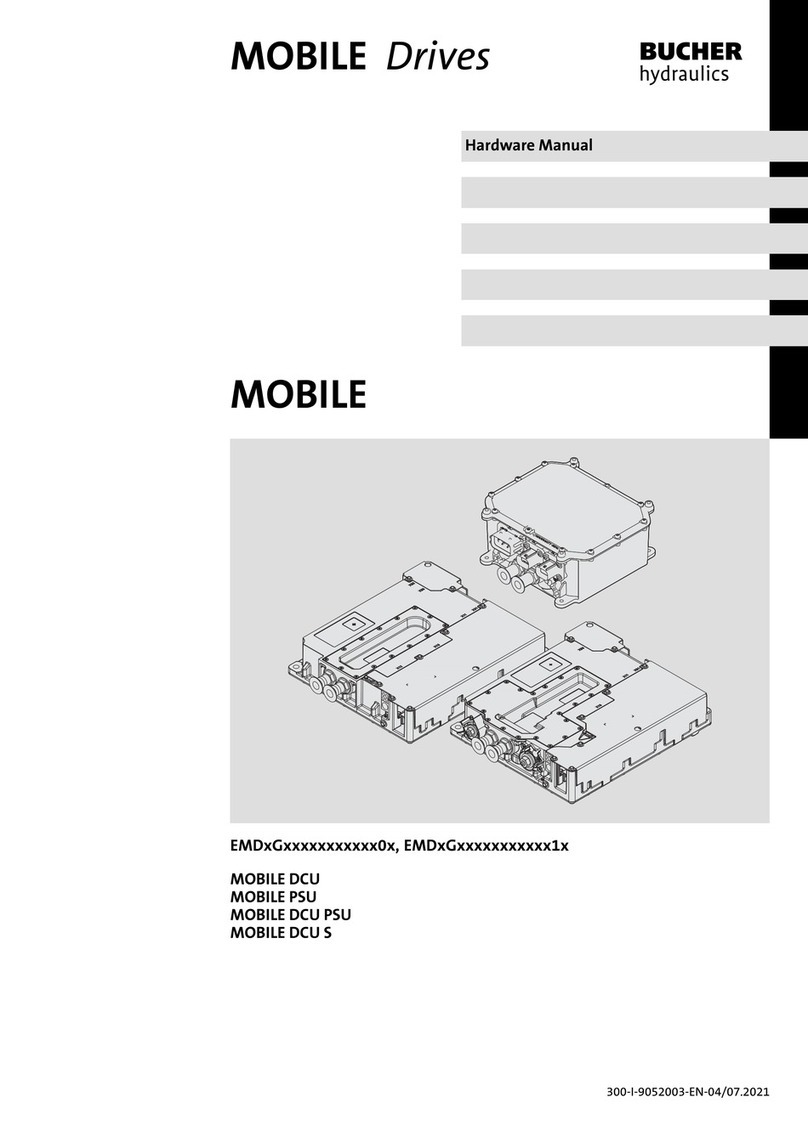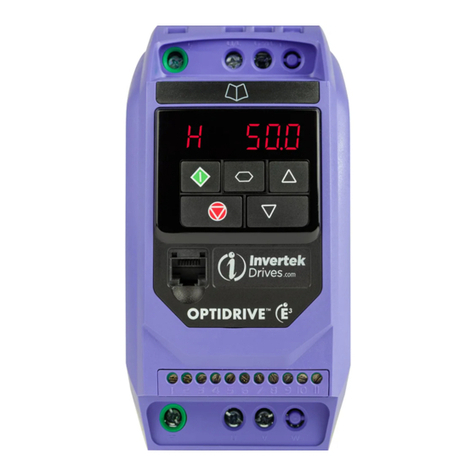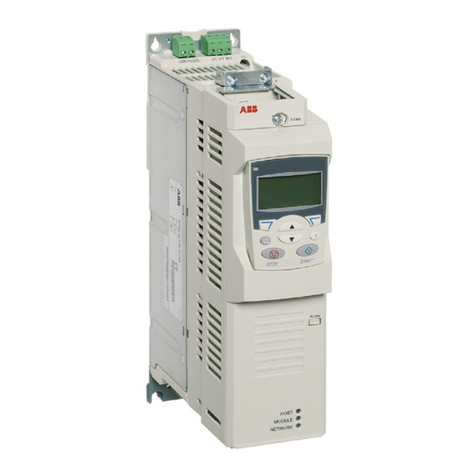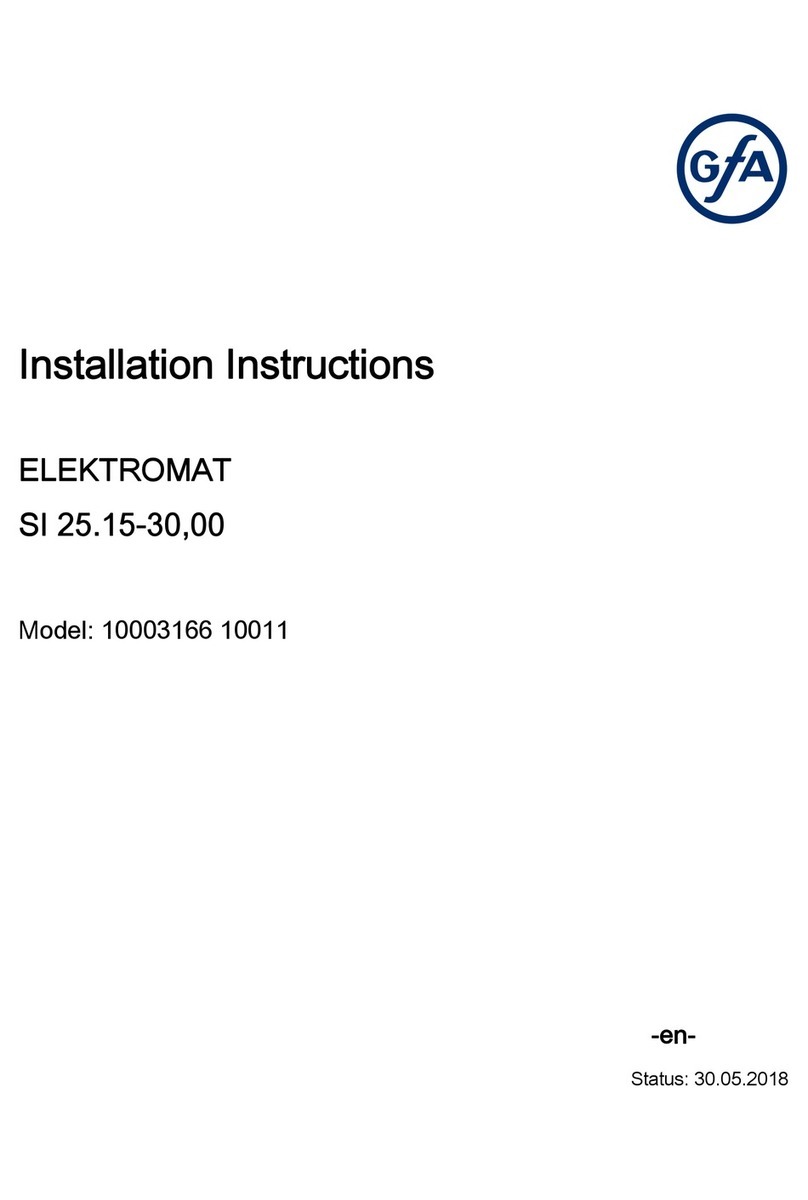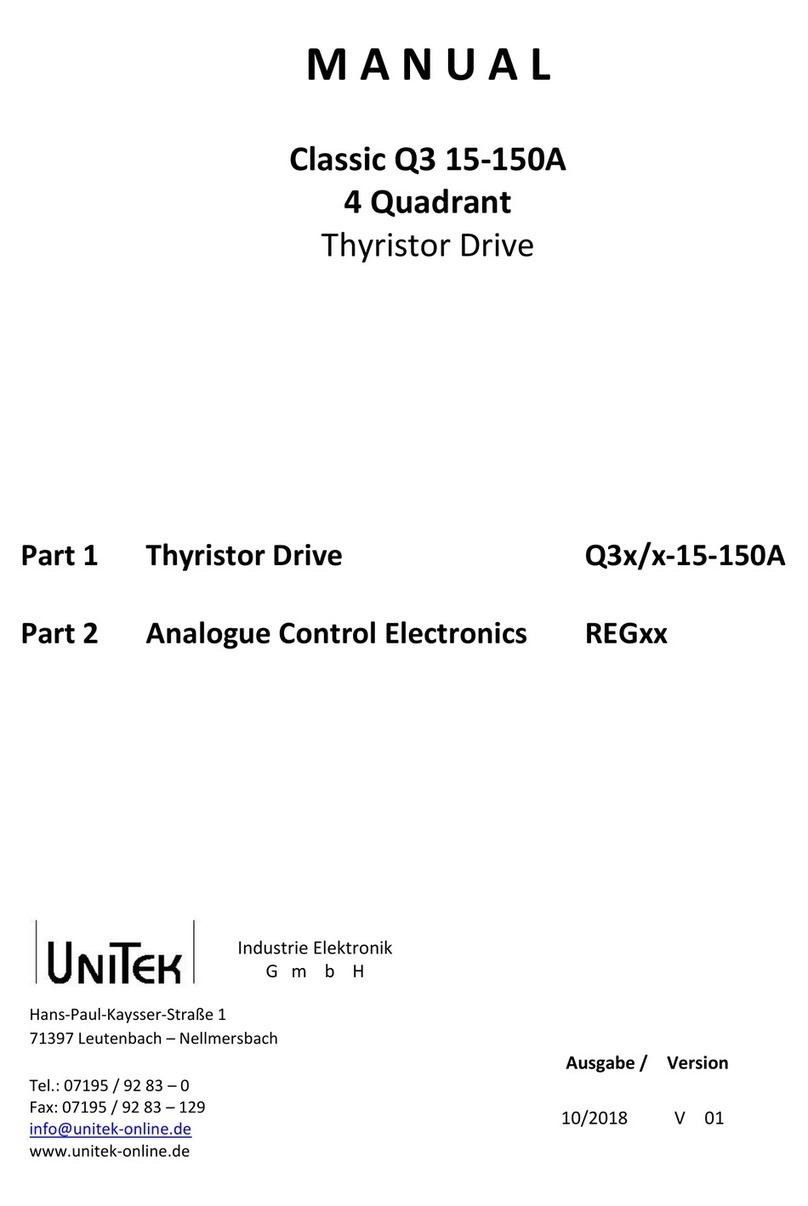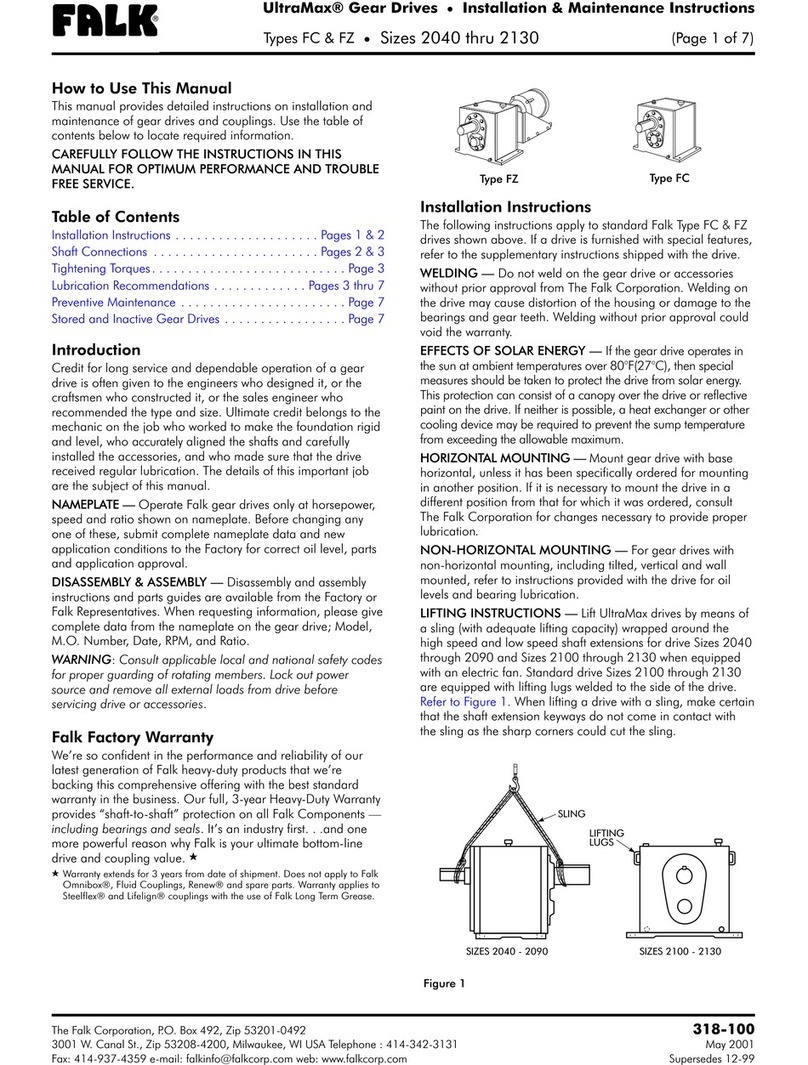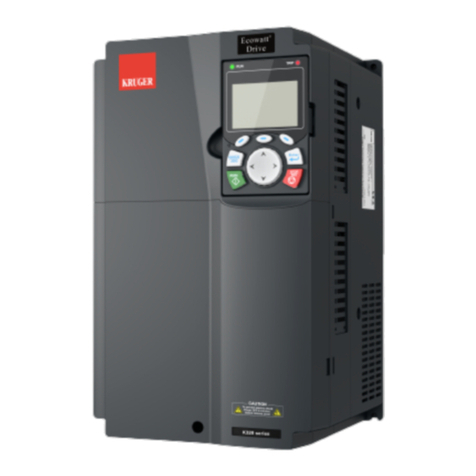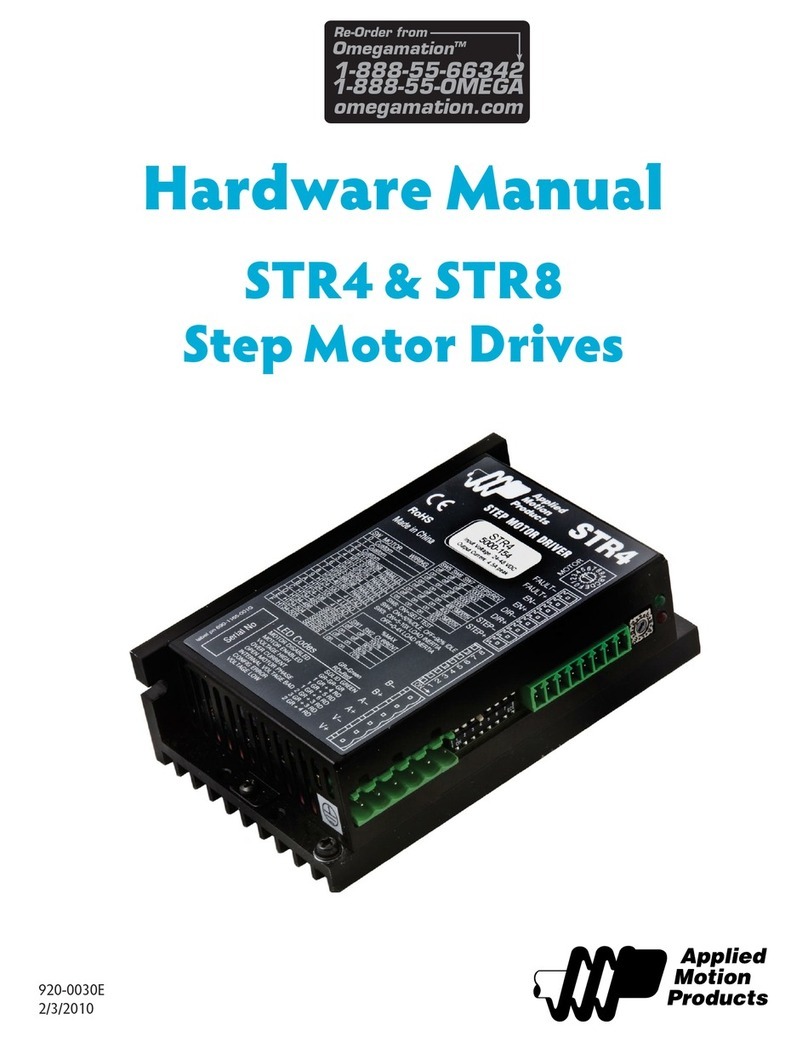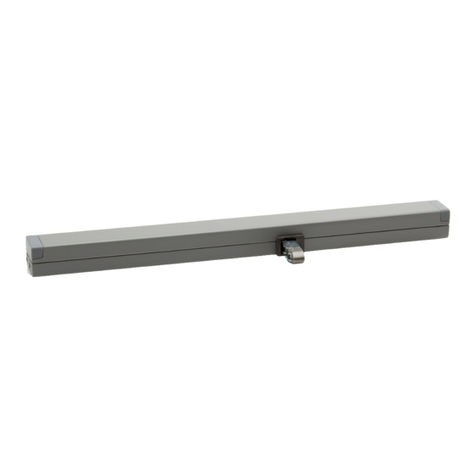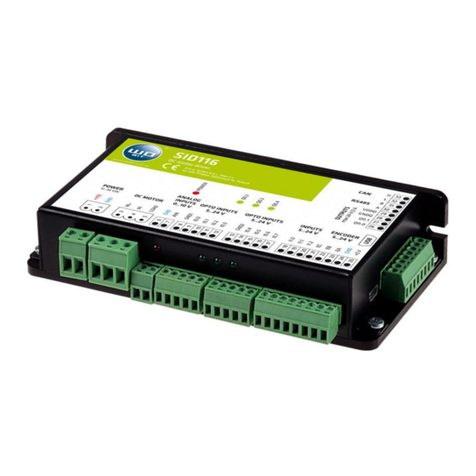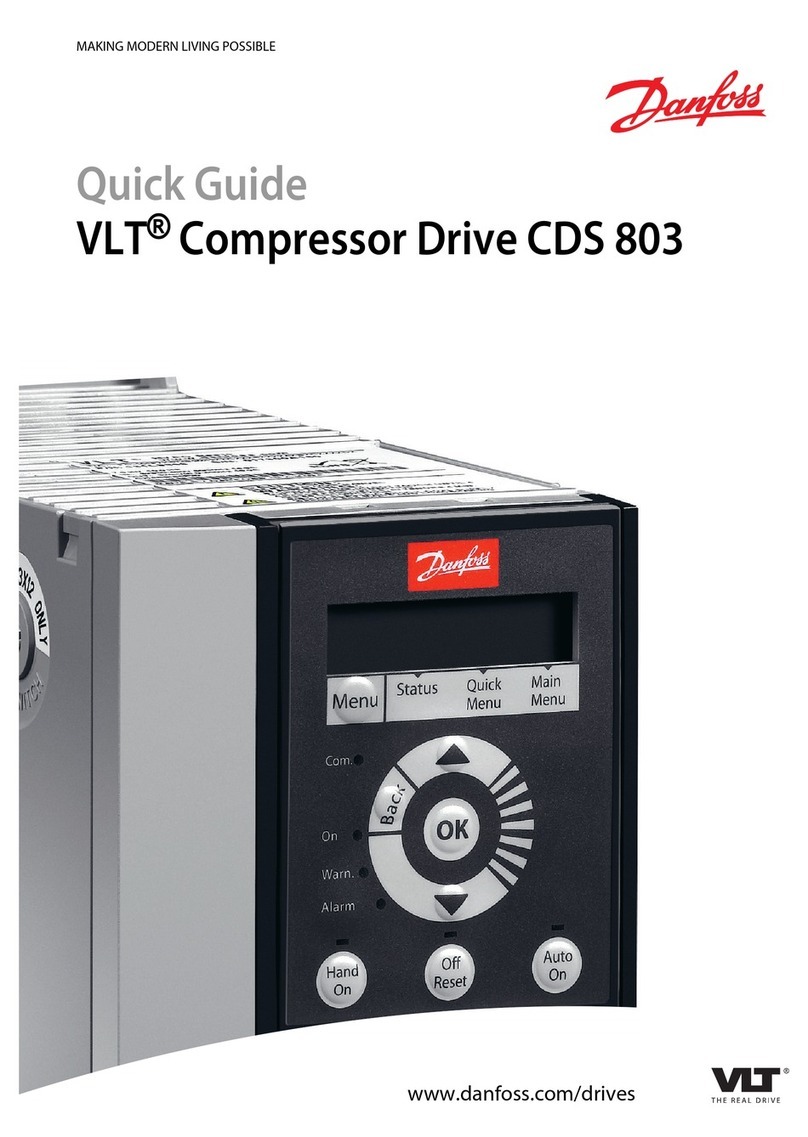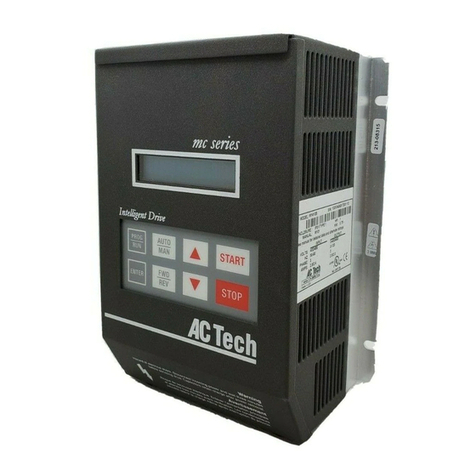WEG CFW100A01P6S220 User manual

Quick Installation Guide
CFW100 Micro Drive
1 SAFETY INSTRUCTIONS
This quick installation guide contains the basic information necessary to commission the CFW100. It has
been written to be used by qualified personnel with suitable training or technical qualification for operating
this type of equipment. The personnel shall follow all the safety instructions described in this manual
defined by the local regulations. Failure to comply with the safety instructions may result in death, serious
injury, and/or equipment damage.
2 SAFETY WARNINGS IN THE MANUAL
NOTE!
It is not the intention of this guide to present all the possibilities for the application of the
CFW100, as well as WEG cannot take any liability for the use of the CFW100 which is not
based on this guide.
For further information about installation, full parameter list and recommendations, visit the
website www.weg.net.
DANGER!
The procedures recommended in this warning have the purpose of protecting the user
against death, serious injuries and considerable material damage.
ATTENTION!
The procedures recommended in this warning have the purpose of avoiding material damage.
NOTE!
The information mentioned in this warning is important for the proper understanding and
good operation of the product.
High voltages are present.
Components sensitive to electrostatic discharge.
Do not touch them.
Mandatory connection to the protective ground (PE).
Connection of the shield to the ground.
3 PRELIMINARY RECOMMENDATIONS
DANGER!
Always disconnect the main power supply before touching any electrical component
associated to the inverter. Several components can remain charged with high voltages or
remain in movement (fans) even after the AC power is disconnected or switched off. Wait at
least ten minutes after turning of f the input power for the complete discharge of the power
capacitors. Always connect the grounding point of the inverter to the protection earth (PE).
Connectors XCA and XCB do not present USB compatibility; therefore, they cannot be
connected to USB doors.
These connectors serve only as inter face between the CFW100 frequency inverter and
its accessories.
NOTE!
Frequency Inverter may inter fere with other electronic equipment. Follow the precautions
recommended in manual available in www.weg.net.
Do not perform any withstand voltage test!
If necessary, contact the manufacturer.
ATTENTION!
Electronic boards have components sensitive to electrostatic discharges.
Do not touch directly on components or connectors. If necessary, first touch the grounding
point of the inverter, which must be connected to the protection earth (PE) or use a proper
grounding strap.
ATTENTION!
When the inverter is stored for a long period, it becomes necessary to per form the capacitor
reforming. Refer to the procedure recommended in www.weg.net.
4 ABOUT THE CFW100
The CFW100 frequency inverter is a high-performance product which allows speed and torque
control of three-phase induction motors. This product provides the user with the options of vector
(VV W ) or scalar (V/f) control, both programmable according to the application.
5 TERMINOLOGY
Tab l e 1: Terminology of the CFW100 inverters
Product
and
Series
Model Identification Degr ee of
Protection
Hardware
Vers ion
Software
Vers ion
Frame
Size
Rated
Current
Phase
Number
Rated
Volt age
E.g.: C FW100 A01P6 S 2 20 --- ---
Available options
CF W10 0
A 01P6 = 1.6 A
S = single-phase
supply 2 = 200...240 V
Blank =
standard
B 02P6 = 2.6 A Sx =
special
software
C 04P2 = 4.2 A
20 = IP20 Blank = standard
Hx = special hardware
6 RECEIVING AND STORAGE
The CF W100 is supplied packed in a cardboard box. There is an identification label affixed to the outside
of the package, identical to the one affixed to the side of the inverter.
Verify whether:
The CF W100 identification label corresponds to the purchased model.
Any damage occurred during transportation.
Report any damage immediately to the carrier.
If the CF W100 is not installed soon, store it in a clean and dry location (temperature between -25 ºC and
60 ºC (-13 ºF and 140 ºF)), with a cover to prevent dust accumulation inside it.
7 IDENTIFICATION LABEL
Production order
Rated input data
(voltage, current and
frequency)
Serial number
Manufacturing date (14 corresponds
to the week and I to the year)
Rated output data
(voltage, current and frequency)
WEG stock item
Model (Inver ter
intelligent code)
Figure 1: Description of the CFW100 identification label
8 DIMENSIONS
VIEW OF THE MOU NTING BASE FRONT VIEW SIDE VIEW
PLB
A
H1
H2
Frame
Size
A B H1 H2 L P Weight
mm
(in)
mm
(in)
mm
(in)
mm
(in)
mm
(in)
mm
(in)
kg
(lb)
A50 (1.97 ) 28 ( 1.1 0 ) 100 (3.94) -5 5 ( 2 .17 ) 129 (5. 08) 0.48 (1.0 5)
B50 (1.97 ) 28 ( 1.1 0 ) -117 (4 . 6 0 ) 55 (2 .17 ) 129 (5 .0 8) 0.57 (1.25)
C50 (1.97 ) 28 ( 1.1 0 ) -125. 6 (4.9 4) 55 (2 .17 ) 129 (5.0 8) 0.61 ( 1.3 4)
Dimension tolerance: ±1,0 mm (±0,039 in)
Figure 2: Inverter dimensions for mechanical installation
9 INSTALLATION AND CONNECTION
Environmental Conditions
Avoid:
Direct exposure to sunlight, rain, high humidity or sea-air.
Inflammable or corrosive gases or liquids.
Excessive vibration.
Dust, metallic particles or oil mist.
Environment conditions permitted for the operation of the inverter:
Temperature surrounding the inverter: 0 ºC to 50 ºC ( 32 ºF to 122 ºF) – IP20.
For temperatures surrounding the inver ter higher than the specifications above, it is necessary to apply
of 2 % of current derating for each degree Celsius, limited to an increase of 10 ºC (50 ºF).
Air relative humidity: 5 % to 95 % non-condensing.
Maximum altitude: up to 1000 m (3.300 ft) - rated conditions.
From 1000 m to 4000 m (3.300 ft to 13.200 ft) – 1 % of current derating for each 100 m above 1000 m
of altitude.
Pollution degree: 2 (according to EN50178 and UL508C), with non-conductive pollution. Condensation
must not originate conduction through the accumulated residues.
10 ELECTRICAL INSTALLATION
DANGER!
The following information is merely a guide for proper installation. Comply with applicable
local regulations for electrical installations.
Make sure the AC power supply is disconnected before starting the installation.
The CFW100 must not be used as an emergency stop device. Provide other devices
for that purpose.
1
1
2
2
4
3
1 - Power terminals
2 - Grounding points
3 - Acces sor y
connectors
4 - Control terminals
Frame
Size
Power
Supply
Recommended Torque
Grounding
Points
Power
Terminals
N.m Lbf.in N.m Lbf.in
A
200...
240 V 1.4 12. 4 1.4 12.4B
C
Figure 3: Power terminals, grounding points and recommended tightening torque
10 .1 POWER CONNECTIONS
Description of the power terminals:
L/L1 and N/L2: AC power supply must be connected to L/L1 and N/L2.
U, V and W: connection for the motor.
PE: grounding connection.
Shield
PE
PEL2L1
Disconnecting
switch
Fusibles
Power supply
PE W V U
L1/ L
L2/N
U V W PE
Figure 4: Power and grounding connections
The CF W100 is suitable for application in a circuit able to supply not more than 30.000 symetric Arms
maximum of 240V, when protected by fuses classified as indicated below:
Tab l e 2: List of models of CFW100 series, ma in ele ctrical specif icati ons
Inverter
Number of Input
Phases
Power Supply
Rated
Volt age
Frame Size
Output
Rated
Current
Maximum
Motor
Circuit
Breaker
Recommended
J Type Fuse
Power Wire
Size
Grounding
Wire Size
[Vrms] [Arms] [HP/kW] [A] WEG [A] mm2
(AWG)
mm2
(AWG)
CFW100A01P6S220 1200 ... 24 0 A1.6 0.25/0.18 5.5 MPW25-3-D063 61.5 (16 ) 2.5 (14)
CF W10 0B 02P6 S2 20 120 0 ... 240 B2.6 0.5/0.37 9.0 MPW25-3-U010 10 1.5 (16) 2.5 (14)
CFW100C04P2S220 1200 ... 24 0 C4.2 1/0.75 13.5 MPW25-3-U016 17.5 1.5 (16) 2. 5 (14)
DANGER!
The inverter must be connected to a protective ground (PE).
Use a minimum wire gauge for ground connection equal to the indicated in Table 2.
Connect the inverter grounding connections to a ground bus bar, to a single ground point
or to a common grounding point (impedance ≤ 10 Ω).
The neuter conductor of the line that feeds the inverter must be solidly grounded; however
this conductor must not be used to ground the inverter.
Do not share the grounding wiring with other equipment that operate with high currents
(e.g.: high voltage motors, welding machines, etc.).
NOTE!
The wire gauges listed in Table 2 are guiding values. Installation conditions and the maximum
permitted voltage drop must be considered for the proper wiring sizing.
10.2 CONTROL CONNECTIONS
DI1
1
DI2
2
S2S1 S3 S4
DI3
3
DI4
GND
4 5
Connector Description (**)
1DI1 Digital input 1
2DI2 Digital input 2
3DI3 Digital input 3 (*)
4DI4 Digital input 4
5GND Reference 0 V
(*) The digital input 3 (DI3) can also be used as inpu t in frequency (FI).
Figure 5: Signals of control card connector of the C100A-20
For the correct connection of the control, use:
1. Gauge of the cables: 0.5 mm² (20 AWG) to 1.5 mm² (14 AWG).
2. Maximum torque: 0.5 N.m (4.50 lbf.in).
3. Wiring of the connector of the control board with shielded cable and separated from the other wiring
(power, command in 110 V / 220 Vac, etc.)
10.3 INSTALLATIONS ACCORDING TO EUROPEAN DIRECTIVE OF ELECTROMAGNETIC
COMPATIBILITY
The CF W100 inverter series, when properly installed, meet the requirements of the directive of the
electromagnetic compatibility.
These inverters were developed for professional applications only. Therefore, the emission limits of
harmonic currents by the standards EN 61000-3-2 and EN 61000-3-2/A 14.
10 .3.1 Conformal Installation
1. Shielded output cables (motor cables) with shield connected at both ends, motor and inverter, by means
of a low impedance to high frequency connection. Maximum motor cable length and conduced and
radiated emission levels according to Table 5. For more information (RFI filter commercial reference,
motor cable length and emission levels) refer to the Table 5.
2. Shielded control cables, keeping the separation distance from other cables according to Table 3.2 the
user's manual.
3. Grounding of the inverter according to instruction of the 3.2.4 Grounding Connections the user's manual.
4. Grounded power supply.
5. The inverter and external filter must be mounted on a common metal plate.
6. The wiring between filter and inverter must be as short as possible.
7. The grounding must be done according to recommendation of the CFW100 user's manual.
8. Use short wiring to ground the external filter or inverter.
9. Ground the mounting plate using a flexible braid as short as possible. Flat conductors have lower
impedance at high frequencies.
10. Use sleeves for cable conduits whenever possible.
10.3.2 Emission and Immunity Levels
Tab l e 3: Emission and immunity levels
EMC Phenomenon Basic
Standard Level
Emission:
Mains terminal disturbance voltage
Freque ncy range: 150 kHz to 30 MHz) IEC/EN 61800-3 It depends on the inverter model on the le ngth of the
motor cable. Refer to Table 5
Electromagnetic radiation disturbance
Freque ncy Range: 30 MHz to 1000 MHz)
Immunity:
Electrostatic discharge (ESD) IEC 61000-4-2 4 kV for co ntact discharge and 8 kV for air discharge
Fast transient-Burst IEC 61000-4-4
2 kV / 5 kHz (coupling capacitor) input cables
1 kV / 5 kHz control cables and remote HMI cables
2 kV / 5 kHz (coupling capacitor) motor cables
Imunidade conduzida ("Conducted radio-
frequency common mode") IEC 61000-4-6 0.15 to 80 MHz; 10 V; 80 % AM (1 kHz)
Motor, control and HMI cables
Surges IEC 61000-4-5
1.2/50 μs, 8/20 μs
1 kV line-to-line coupling
2 kV line-to-ground coupling
Radio-frequency electromagnetic field IEC 61000-4-3
80 to 1000 MHz
10 V/m
80 % AM (1 kHz)
Definition of Standard IEC/EM 61800 -3: “Adjustable Speed Electrical Power Drives Systems”
Environments:
First Environment: environments that include domestic installations, as well as establishments directly
connected without intermediate transformer to a low-voltage power supply network which supplies
buildings used for domestic purposes.
Second Environment: includes all establishments other than those directly connected to a low voltage
power supply network that supplies buildings used for domestic purposes.
Categories:
Category C1: inverters with a voltage rating less than 1000 V and intended for use in the First Environment.
Category C2: inverters with a voltage rating less than 1000 V intended for use in the First Environment,
not provided with a plug connector or movable installations. They must be installed and commissioned by
a professional.
NOTE!
A professional is a person or organization familiar with the installation and/or commissioning
of inverters, including their EMC aspects.
Category C3:inverters with a voltage rating less than 1000 V and intended for use in the Second
Environment only (not designed for use in the First Environment).
10.3.3 Characteristics of the RFI Filter
The CF W100 inverters, when installed with external filter, are used to reduce the conducted from the
inver ter to the power line in the high frequency band (>150). It is necessary to meet the ma ximum levels of
conducted emission of electromagnetic compatibility standards, such as EN 61800-3 and EN 55011.
For further information about the RFI filter model, refer to Table 4.
The figure below demonstrate the connection of the filter to the inverter:
Protective ground
Metal panel (when necessary)
Grounding
rod
External
input
RFI filter
PE
PE PE
W
V
U
Signal and control wiring
Transformer
L1/ L L1 L1/ L
1...5
XC1
PE PE
L2/N L2 L2/N
CF W10 0 Motor
Power supply
Figure 6: Connection of the RFI filter - general cond itions
English
132304 5 3

Tab l e 4: E xte rnal R FI filter models for CFW100
WEG Item Name Description
13128410 CFW100-KFABC External RFI filter k it WEG
- - Filter B 84142A0010R000 Epcos (*)
(*) For Electrodiagnostica Radiation Disturbance use choke (T60006- L2016-W403 – VACUUMSCHMELZE).
Tab l e 5: Conducted and radiate d emission levels, and addi tional information
Inverter Model
Conducted Emission – Maximum Motor Cable
Length Radiated Emission
Category C2 Category C3 Category C3
1CFW100A01P6S220
1 m (39 in) 10 m (393 in) 10 m (393 in)
2CF W10 0B 02P6 S2 20
3CFW100C04P2S220
(1) The switching fre quen cy is 5 KHz.
10.4 ACCESSORIES
The accessories are hardware resources that can be added in the application with the CFW100.
The accessories are incorporated to the inverters in an easy and quick way by using the concept “Plug and
Play”. The accessor y must be installed or modified with the inverter de-energized. They may be ordered
separately, and are sent in their own package containing the components and manuals with detailed
instructions for their installation, operation and setting.
11 USE OF THE KEYPAD TO OPERATE THE INVERTER
Selects (toggles)
display betwe en the
parameter number
and its value (position/
content).
Decreases the
frequency, parameter
number or parameter
value.
Increases the
frequency, parameter
number and parameter
value.
Enables/disables the inverter
via acceleration/deceleration
ramp (start/stop, according to
P229). Resets the inve rter a fter
a fault event.
11.1 INDICATIONS OF DISPLAY
Inverter status
Direction of
rotation
Unit of measurement
(it refe rs to the va lue
of the main display)
Bar to monitor
the variable
Main display
11. 2 OPERATING MODES OF THE HMI
Initialization Mode
It is the in itial state of th e HMI after its s uccessfu l power-up (witho ut
the occurrence of faults, alarms or undervoltage).
Press key to go to level 1 of the parameterizatio n mode –
selection of parameters. Pressing any other key al so switches to
parameterization mode.
Monitoring
Parameterization
Leve l1
Parameterization
Level 2
Parameterization Mode
Level 1:
This is the fir st level of the par ameterization mod e. The parameter
number is shown on the main display.
Use keys and to find the desired parameter.
Press key to go to level 2 of the parameter izati on mode -
change of the parameter values.
Level 2:
The parameter value is shown on the main display.
Use keys and to set the new value in the selected
parameter.
Press key to confirm the modi fication (save the new value).
After confirming the modific ation, the HMI returns to l evel 1 of the
parameterization mode .
Figure 7: HMI operating modes
12 START-UP PREPARATION
DANGER!
Always disconnect the main power supply before making any connection.
1. Check if the power, grounding and control connections are correct and firm.
2. Remove all the materials left behind from the installation work from inside the inverter or the cabinet.
3. Verif y the motor connections and if its voltage and current are within the inverter rated value.
4. Mechanically uncouple the motor from the load. If the motor cannot be uncoupled, make sure that
any speed direction (forward or reverse) will not result in personnel injury and/or equipment damage.
5. Close the inverter or cabinet covers.
6. Measure the power supply and verify if it is within the allowed range.
7. Apply power to the input: close the input disconnecting switch.
8. Check the result of the first time power-up:
The HMI display indicates:
12 .1 BASIC APPLICATION
The following table contains the basic programming to operate the CFW100 via product HMI:
Seq Display Indication/Action Seq Display Indication/Action
12
Initialization mode.
Press key to enter the first level of the
parameterization mode.
Press keys or to select the parameter P100.
Press key if you ne ed to cha nge the content of
P100 – “Acceleration T ime” or p ress key for the
next parameter.
3 4
If nece ssary, change the content of “ P101 -
Deceleration Time”.
Use key to select the parameter P133.
If nece ssary, change the content of “P133 - Minimu m
Sp e e d ”.
Press key for the next parameter.
5 6
If nece ssary, chan ge the content of “P134 - Max imum
Sp e e d ”.
Press key for the next parameter.
If nece ssary, change the co ntent of “P135 - Output
Maximum Current”.
Press key to select parameter P0 02.
7 8
Press key to view the parameter c ontent. Press key that th e motor will accelerate up to
3.0 Hz (factory default setting of P133 - Minimum
Freq uency).
Press and hold it until it reaches 60.0 Hz.
910
Press key . The motor will d ecelerate to a stop. When the motor stops, the display will indicate
“r e ady”.
12. 2 TYPE OF CONTROL V/f (P202 = 0)
Seq Display Indication/Action Seq Display Indication/Action
12
Initialization mode.
Press key to enter the first level of the
parameterization mode.
Press keys or to select paramete r P202.
34
Press key if you need to change the content of
“P202 – Type of Co ntrol” for P202 = 0 ( V/f).
Pres s key to select paramete r P401.
If nece ssary, change the content of parameter “P401
– Motor Rate d Current” according to the nameplate.
Press key for the next parameter.
56
If nece ssary, change the co ntent of “P402 - Motor
Rated Speed”.
Press key for the next parameter.
If nece ssary, change the co ntent of “P403 - Motor
Rated Frequency”.
13 TECHNICAL SPECIFICATIONS
PO WER DATA
Power Supply:
Tolerance: -15 % to +10 %.
Frequency: 50/60 Hz (48 Hz to 62 Hz).
Phase imbalance: ≤ 3 % of the rated phase-to-phase input voltage.
Over voltage according to Category III (EM 61010/UL 508C).
Transient voltages according to Category III.
Maximum of 10 connections per hour (1 every 6 minutes).
Typical efficiency: ≥ 97 %.
14 ELECTRONICS/GENERAL DATA
Table 6: Electronics/general data
Control Method Types of control:
- V/f (Scalar)
- VVW: voltage vector control
PWM SVM (Space Vector Modulation)
Output frequency 0 to 300 Hz, re solution of 0.1 Hz
Performance V/f Control Speed reg ulation: 1 % of the rated spe ed (with slip compensation)
Speed variation range: 1:20
Vector control ( V V W) Speed regulation: 1 % of the rated s peed
Speed variation range: 1:30
Inputs Digital 4 isolated inputs
Maximum input vol tage of 30 Vdc
Input current: - 11 mA
Maximum input current: -20 m A
Safety Protection Output overcurrent/short-circuit
Under/overvoltage
Motor overload
Over temperature in the power module (IGBTs)
Fault / ex ternal alarm
Programming error
Integral keypad
(HMI)
Standard keypad 4 keys: Start/Stop, Up arrow, Down ar row and Programming
LCD Display
View/edition of parameters
Indication accuracy:
- current: 5 % of the rated current
- speed resolution: 0.1 Hz
Enclosure IP20 Frame Sizes A, B and C
15 CONSIDERED STANDARDS
Tab l e 7: Considered standards
Safety
standards
UL 508C - power conversion equipme nt
UL 840 - insulation coordination including clearances and creepage distances for electrical
equipment
EN61800-5-1 - safety requirements electrical, thermal and energy
EN 50178 - electron ic equipment for use in power installations
EN 60204-1 - safety of machine ry. Electrical equipment of machines. Part 1: general re quirements
Note: the final assembler of the machine is responsible for installing a safety stop device and a
supply disconnecting device
EN 60146 (IEC 146) - semiconductor converters
EN 61800-2 - adjusta ble speed el ectrical power drive syste ms - Part 2: gene ral require ments - rating
specifications for low voltage adjustable frequency AC power drive systems
Mechanical
standards
EN 60529 - degree s of protection provided by enclosures (IP code)
UL 50 - enclosures for electrical equipment
Electromagnetic
compatibility
(EMC)
standards (*)
EN 61800-3 - adjustable speed electrical power dr ive systems - part 3: EMC product standard
including specific test methods
EN 55011 - limits and methods of measurem ent of radio disturbance characteristics of industrial,
scientific and medical (ISM) radio-frequency equipment
CISPR 11 - industrial, scientific and medical (ISM) radio-frequency equipme nt - electromagnetic
disturbanc e characteristic s - limits and methods of measu rement
EN 61000-4-2 - electromagnetic compatibility (EMC)- par t 4: testing and measurement techniques
- section 2: electrostatic discharge immunity test
EN 61000-4-3 - electromagneti c compatibil ity (EMC) - par t 4: testin g and measure ment techniques
- section 3: radiated, radio-frequency, electromagnetic field immunity test
EN 61000-4-4 - ele ctromagneti c compatibil ity (EMC) - par t 4: testing and measure ment techniques
- section 4: electrical fast transient/burst immunity test.
EN 61000-4-5 - ele ctromagneti c compatibil ity (EMC) - par t 4: testin g and measure ment techniques
- section 5: surge immun ity test.
EN 61000-4-6 - ele ctromagnetic comp atibility (EMC) - par t 4: testing and me asurement te chniques
- section 6: immu nity to condu cted disturb ance s, indu ced by radio-frequency fields.
(*) Stand ards met with th e installati on of the external RFI filter. For fur ther details refer to www.weg.net.
16 MAIN PAREMETERS
The table below contains the mains parameters of the CFW100.
NOTE!
ro = read only parameter.
V/f = parameter available in V/f mode.
cfg = configuration parameter, value can only be changed with the motor stopped.
Param. Description Adjustable Range Factory Setting Prop.
P000 Access to Parameters 0 to 9999 1
P001 Speed Reference 0 to 9999 ro
P002 Output Speed (Motor) 0 to 9999 ro
P003 Motor Current 0.0 to 10.0 A ro
P004 DC Lin k Voltage (Ud) 0 to 524 V ro
P005 Output Frequency (Motor) 0.0 to 300.0 Hz ro
P006 Inverter Status 0 = Ready
1 = Run
2 = Undervoltage
3 = Fault
4 = Not Used
5 = Configuration
ro
P007 Output Voltage 0 to 240 V ro
P0 11 Active Current -10.0 to 10.0 A ro
P012 DI 8 to DI1 Status 0 to FF (hexa)
Bit 0 = DI1
Bit 1 = DI2
Bit 2 = DI3
Bit 3 = DI4
Bit 4 = DI5
Bit 5 = DI6
Bit 6 = DI7
Bit 7 = DI8
ro
P022 FI Value in Hz 1 to 30 00 Hz ro
P023 Main SW Version 0.00 to 99.99 ro
P030 Module Temperature -200.0 to 200.0 ºC ro
P037 Motor O verload Ixt 0.0 to 100.0 % ro
P047 CONFIG Status 0 to 999 ro
P048 Present Alarm 0 to 999 ro
P049 Present Fault 0 to 999 ro
P050 Last Fault 0 to 999 ro
P100 Acceleration Time 0.1 to 999.9 s 5.0
P101 Deceleration Time 0.1 to 999.9 s 10.0
P120 Speed Ref. Backup 0 = Inactive
1 = Active
2 = Backu p by P121
1
P121 Referenc e via HM I 0.0 to 300.0 Hz 3.0 Hz
P124 Multisp eed Ref. 1 -300.0 to 300.0 Hz 3.0 Hz
P125 Multispeed Ref. 2 -300.0 to 300.0 Hz 10.0 (5.0) Hz
P126 Multispeed Ref. 3 -300.0 to 300.0 Hz 20.0 (10.0) Hz
P127 Multispeed Ref. 4 -300.0 to 300.0 Hz 30.0 (20.0) Hz
P128 Multispeed Ref. 5 -300.0 to 300.0 Hz 40.0 (30.0) Hz
P129 Multispeed Ref. 6 -300.0 to 300.0 Hz 50.0 (40.0) Hz
P130 Multispeed Ref. 7 -300.0 to 300.0 Hz 60.0 (50.0) Hz
P131 Multispe ed Ref. 8 -300.0 to 300.0 Hz 66.0 (55.0) Hz
P133 Minimum Frequency 0.0 to 300.0 Hz 3.0 Hz
P134 Maximum Frequency 0.0 to 300.0 Hz 66.0 (55.0) Hz
P135 Maximum Output Current 0.0 to 10.0 A 1.5xI nom
P136 Manual Torque Boost 0.0 to 30.0 % 0.0 % V/f
P137 Automatic Torque Boost 0.0 to 30.0 % 0.0 % V/f
P138 Slip Compensation -10.0 to 10.0 % 0.0 % V/f
P139 Output Current Filter 0 to 9.999 s 0.005 s
P140 Slip Com. Filter 0 to 9.999 s 0.5 s VVW
P142 Maximum Output Voltage 0.0 to 100.0 % 100.0 % cf g, V/f
P143 Intermediate Output
Voltage
0.0 to 100.0 % 50.0 % cfg, V/f
P145 Field Weakening Start
Frequency
0.0 to 300.0 Hz 60.0 (50.0) Hz c fg, V/f
P146 Intermediate Frequency 0.0 to 300.0 Hz 30.0 (25.0) Hz cfg, V/f
P156 Overload Current 0.1 to 2xInom 1.2xInom
P202 Type of Control 0 = V/f
1 = V/f Quadratic
2 to 4 = Not Used
5 = V V W
0cfg
P204 Load/Save Parameters 0 to 4 = Not Used
5 = Load 60 Hz
6 = Load 50 Hz
7 = Load Use r
8 = Not Used
9 = Save User
10 = Not Used
11 = Load Default SoftPLC
12 to 13 = Reserved
0cfg
P220 LOC/REM Selection
Source
0 = Always Local
1 = Always Remote
2 to 3 = Not Used
4 = DIx
5 = Serial/USB (LOC)
6 = Serial/USB (REM)
7 to 8 = Not Used
9 = CO/DN (LOC)
10 = CO/DN (REM)
11 = SoftPLC
0 cfg
P221 LOC Reference Sel. 0 = HMI Keys
1 = AI1
2 to 3 = Not Used
4 = FI
5 to 6 = Not Used
7 = E.P.
8 = Multispeed
9 = Serial/USB
10 = Not Used
11 = CO/DN
12 = SoftPLC
13 = Not Used
14 = AI1 > 0
15 to 16 = Not Used
17 = FI > 0
0 cfg
Param. Description Adjustable Range Factory Setting Prop.
P222 REM Reference S el. See option s in P221 2 cfg
P223 LOC Rotation Sel. 0 = Al ways FWD
1 = Always R EV
2 = Not Used
3 = Not Used
4 = DIx
5 = Serial/USB (FWD)
6 = Serial/USB (REV)
7 to 8 = Not Used
9 = CO/DN (F WD)
10 = CO/DN (RE V)
11 = Not Used
12 = SoftPLC
0cfg
P263 DI1 Input Function 0 = Not Used
1 = Run/Stop
2 = General Ena ble
3 = Quick Stop
4 = Forward Run
5 = Reverse Run
6 = Star t
7 = Stop
8 = FWD/R EV
9 = LOC/REM
10 = JOG
11 = Increase E.P.
12 = Decelerate E.P.
13 = Multispeed
14 = 2nd Ramp
15 to 17 = Not Used
18 = No Ext. Alarm
19 = No Ext. Fault
20 = Reset
21 to 23 = Not Used
24 = Disab. Flying Start
25 = Regul. DC Link
26 = Lock Pro g.
27 to 31 = Not Used
32 = 2nd Ramp Multispeed
33 = 2nd Ramp E.P. Ac.
34 = 2nd Ramp E.P. De.
35 = 2nd Ramp FRW Run
36 = 2nd Ramp R ev Run
37 = Turn ON / Ac. E.P.
38 = De. E.P. / Turn OFF
39 = Stop
40 = Safet y Switch
41 = Function 1 Application
42 = Function 2 Application
43 = Function 3 Application
44 = Function 4 Application
45 = Function 5 Application
46 = Function 6 Application
47 = Function 7 Application
48 = Function 8 Application
1cfg
P264 DI2 Input Function See options in P263 8 cfg
P265 DI3 Input Function See options in P263 0 cfg
P266 DI4 Input Function Se e options in P263 0 cfg
P295 Inv. Rated Current 1.6 to 15.2 A According to
inverter model
ro
P296 Line Rated Voltage 0 to 1 = Re ser ved
2 = 200 - 240 V
2 ro, cfg
P297 Switching Frequency 2.5 to 15.0 kHz 5.0 kHz
P401 Motor R ated Current 0.0 to 10.0 A 1.4 A cfg
P402 Motor Rated Speed 0 to 9999 rpm 1720 (1310) rpm cfg
P403 Motor Rated Frequency 0 to 300 Hz 60 (50) Hz cfg
17 FAULTS AND ALARMS
Most common faults and alarms
Fault / Alarm Description Possible Causes
A046
Motor Overload
Motor overload alarm Settings of P156 is too low for the used motor
Overl oad on th e motor sh aft
A050
Power Module
Overtemperature
Overtemperature alarm from the
power module temperature sensor
(NTC)
High temperature at IG BTs (P030 > 110 °C)
High ambient temperature around the inve rter (>50 °C (>
122 °F)) and hi gh output cur rent
Blocked or defective fan
Heatsink is too dirt y, preventing the air flow
A090
External Alarm
Exte rnal a larm v ia DIx (option “N o
Exte rnal A larm” in P26x)
Wiring on DI1 to DI4 inputs are open or have poor contact
A700
Remote HMI
Communication Fault
No communication with remote HMI,
but here is frequency command or
refere nce for this source
Check if the communication interface with the HMI is
properly configured in parameter P312
HMI cable disconnected
F021
Undervoltage on the
DC Link
Undervoltage fault on the intermediate
circuit
Wrong voltage supply; check if the data on the inverter
label comply with the power supply and parameter P296
Suppl y voltage too low, pro ducing voltage on the DC link
below the minimum value (in P004):
Ud < 200 Vdc in 200 / 240 Vac
Phase fault in the inpu t
Fault in the pre-charge circuit
F022
Overvoltage on the
DC Link
Overvoltage fault on the intermediate
circuit
Wrong voltage supply; check if the data on the inverter
label comply with the power supply and parameter P296
Supply voltage is too high, producing voltage on the DC
link above the ma ximum valu e (in P0 04):
Ud > 410 Vdc in 200 / 240 Vac
Load inertia is too high or deceleration ramp is too fast
P151 setting is too high
F031
Fault of
communication with
the accessory
Main control cannot e stablish the
communication link with accessory
Accessory damaged
Poor connection of the accessory
Proble m in the identi fication of th e accessor y; refer to P027
F051
IG B Ts
Overtemperatures
Overtemperature fault measured
on the temperature sensor of the
power pack
High temperature at IG BTs (P030 > 120 °C)
High ambient temperature a round the inverter (>50 °C
(>122 °F)) and high output current
Blocked or defective fan
Heatsink is too dirt y, preventing the air flow
F070
Overcurrent/
Shortcircuit
Overcurrent or short-circuit on the
output, DC link o r brak ing resistor
Short-circuit between two motor phases
IGBTs module in short-circuit or damaged
Star t with too shor t acceleration ramp
Start with motor spinning without the Flying Start function
F072
Motor Overload
Motor overload fault
(60 s in 1.5 x Inom)
P156 setting is too low in relation to the motor operating
current
Overl oad on th e motor sh aft
F080
CPU Fault
(Watchdog)
Fault related to the supervision
algor ithm of the inverter main CPU
Electric noise
Inverter firmware fault
F081
Fault on the Save
User function
Fault in the attempt to save the user
parameter table
Attempt to save (P20 4 = 9) more than 32 paramete rs
(with values diffe rent from the factory defau lt) on the User
parameter table
The function Saves User is blocked
F082
Fault in the Copy
Function (MMF)
Fault in the copy of parameters Attempt to c opy the parameters from the Fl ash Me mor y
Modul e to the inve rter with different sof twa re vers ions
F084
Auto-diagnosis
Fault
Fault related to the automatic
identification algorithm of the inverter
hardware
Poor contact in the connection between the main control
anthe power pac k
Hardware not compatible with the firmware version
Defect on the internal circuits of the i nver ter
F091
External Fault
Exte rnal fault via DIx (“No Ex ternal
Fault” in P26x)
Wiring on DI1 to DI4 inputs are open or have poor contact
F701
Remote HMI
communication fault
No communication with the remote
HMI; however, there is command or
frequ ency reference for th is source
Check that the HMI communication interface is properly
configured in para meter P312
HMI cable disconnected
NOTE!
For further information, refer www.weg.net.
Document: 10003540581 / 00
This manual suits for next models
2
Other WEG DC Drive manuals

WEG
WEG CFW-11 Series User manual
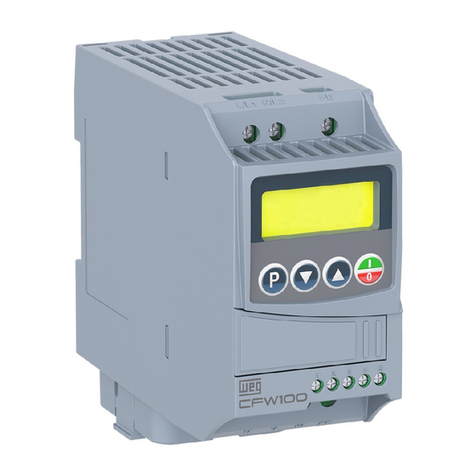
WEG
WEG CFW100 series Owner's manual
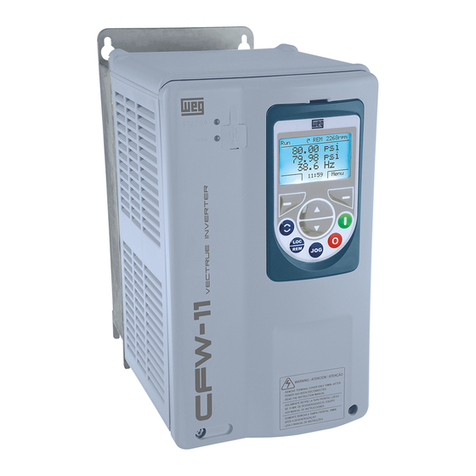
WEG
WEG CFW-11 Series Owner's manual

WEG
WEG MW500 series User manual

WEG
WEG CFW-11 Series Owner's manual
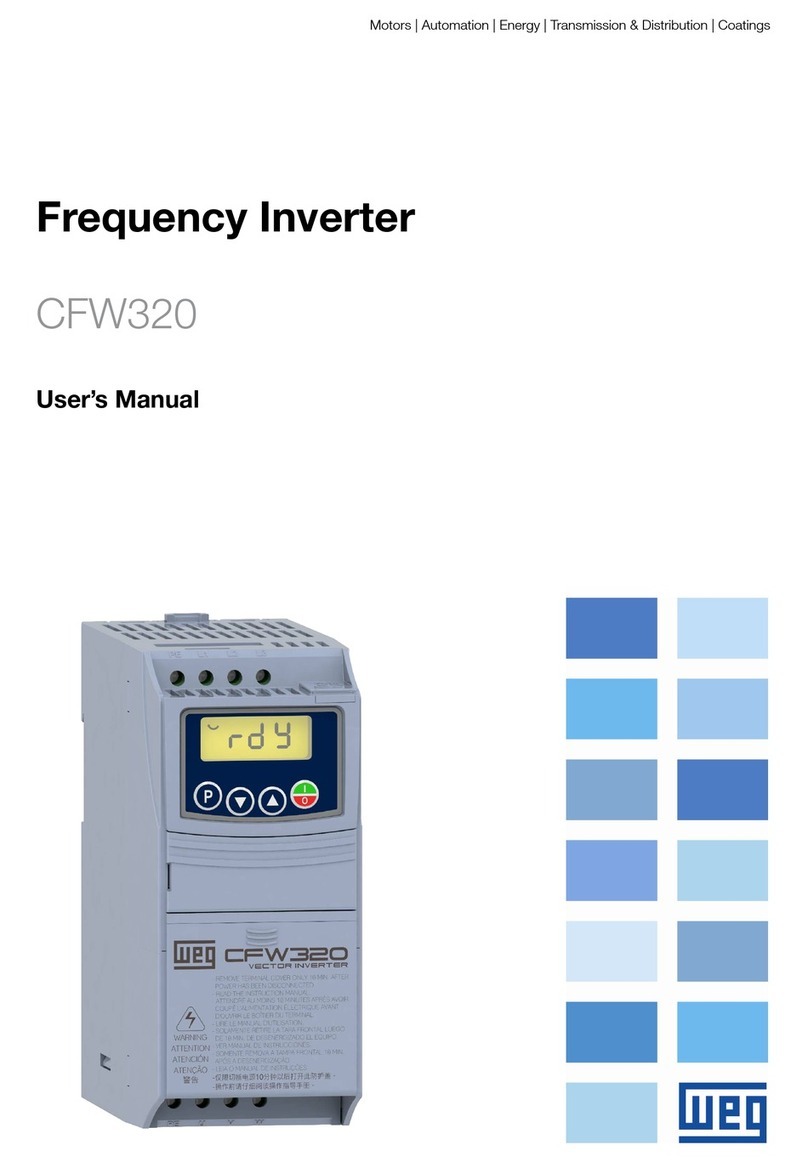
WEG
WEG CFW320 User manual
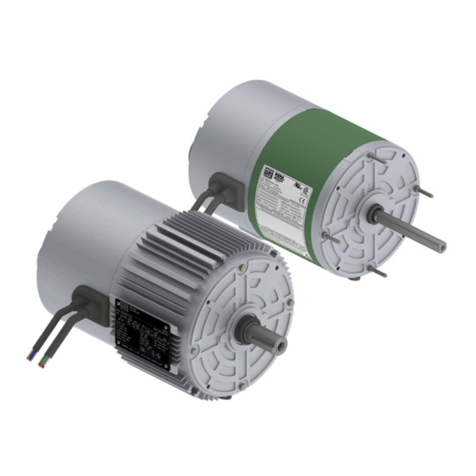
WEG
WEG WECM-AL80-85A2 User manual

WEG
WEG DeviceNet CFW500 User manual

WEG
WEG CFW-11 Series Operating instructions
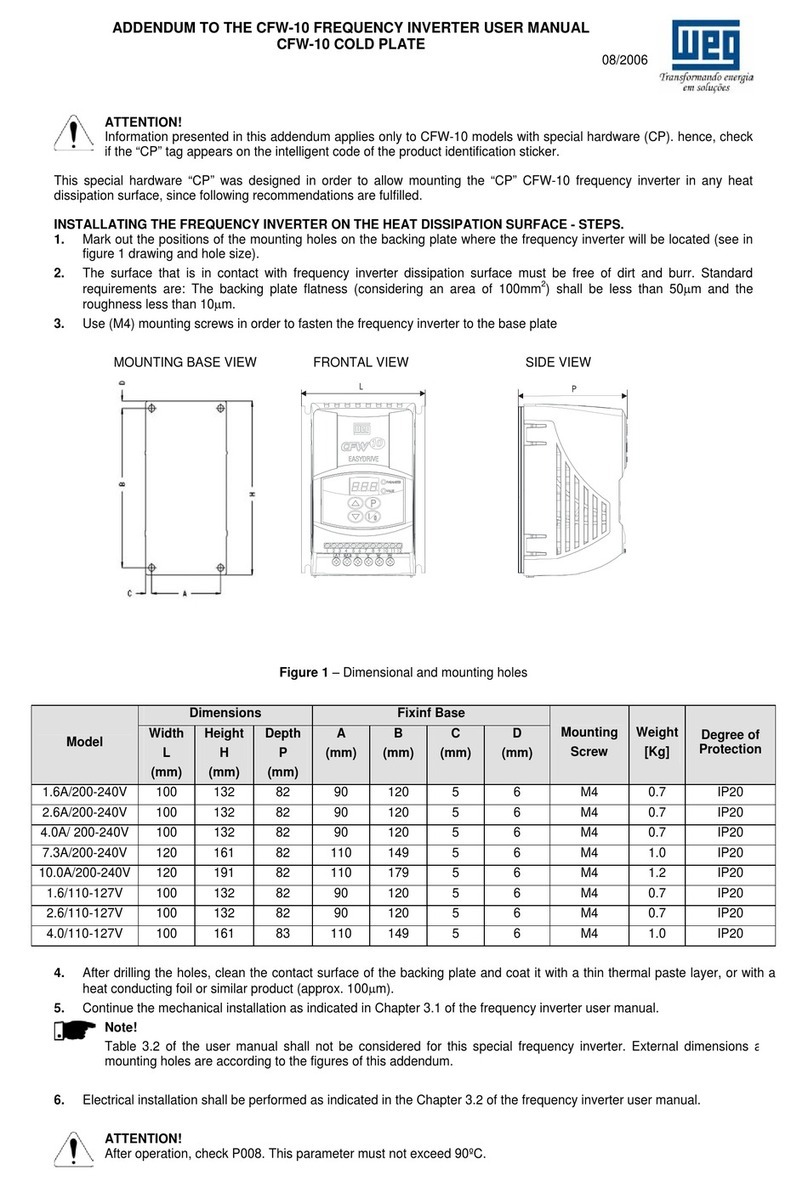
WEG
WEG Easy Drive CFW10 Installation and operating instructions

WEG
WEG CFW900 User manual

WEG
WEG CFW100 series User manual

WEG
WEG CFW-11 Series User manual
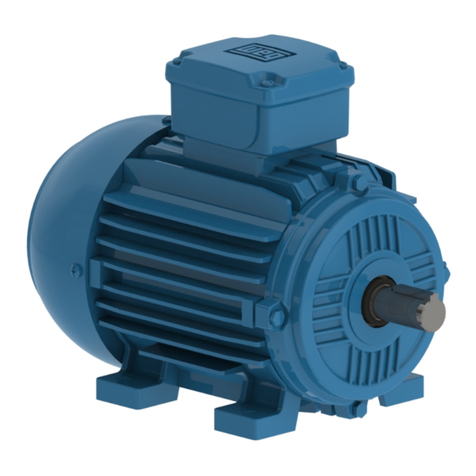
WEG
WEG W21 User manual
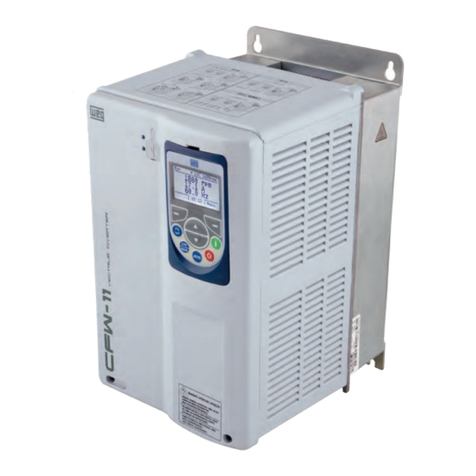
WEG
WEG CFW-11 Series User manual
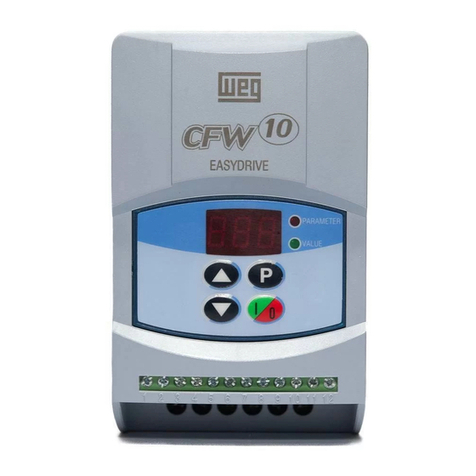
WEG
WEG CFW-10 EASYDRIVE User manual

WEG
WEG CFW-11 Series User manual
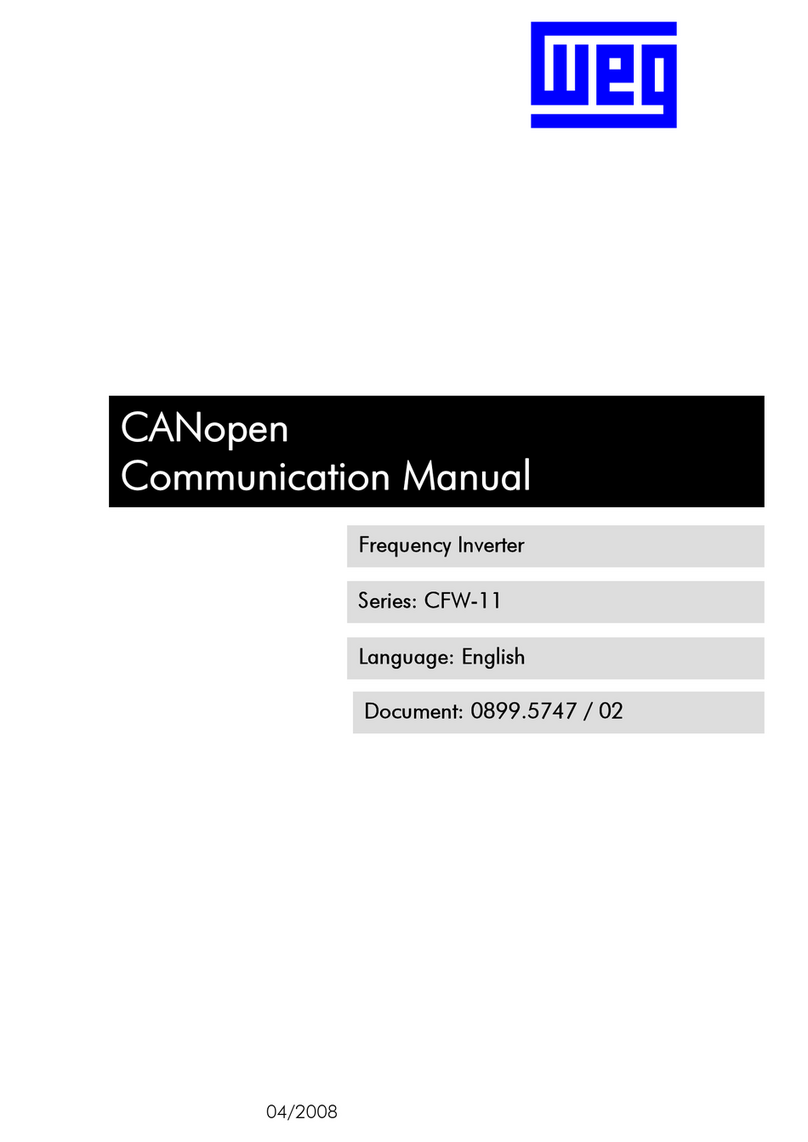
WEG
WEG CFW-11 Series Use and care manual
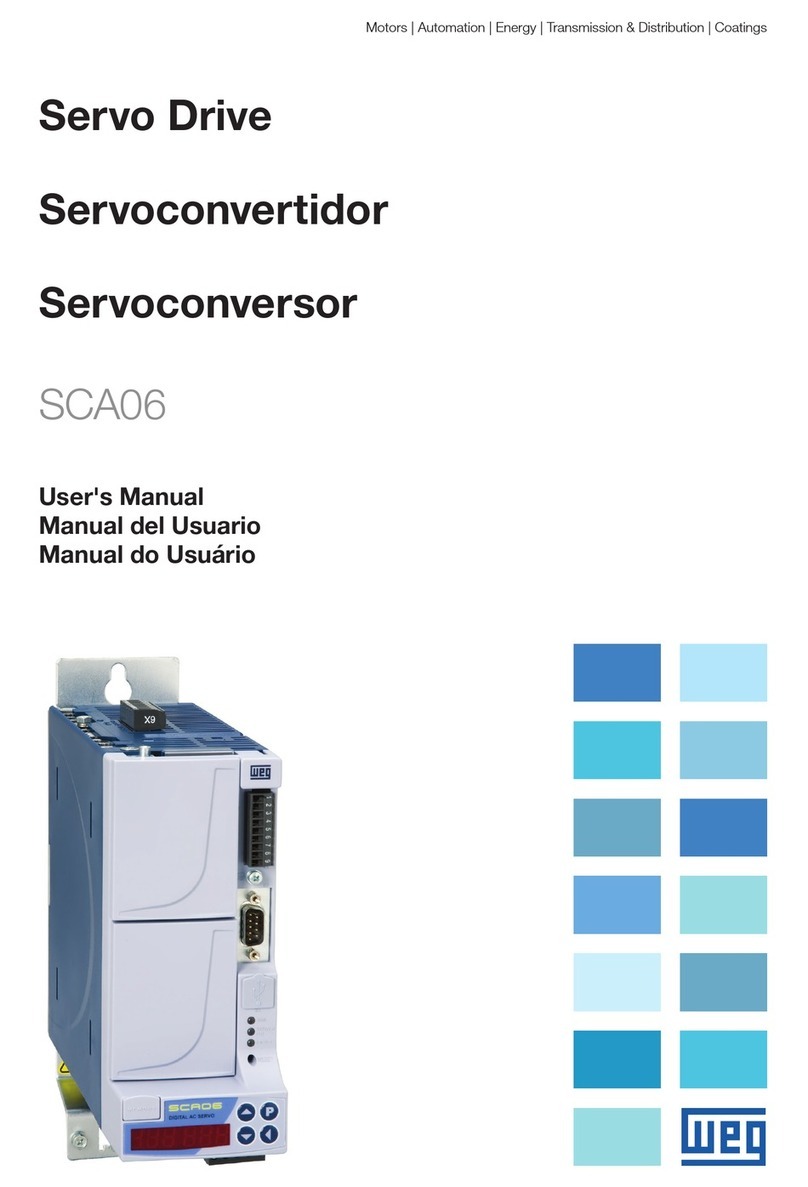
WEG
WEG SCA06 User manual

WEG
WEG MVW3000 Series Owner's manual

